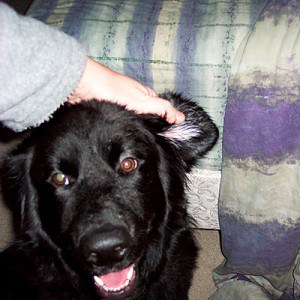Most healthy Labrador dogs will have few problems with their ears. There are, however, several conditions that can arise with regards to a dog’s ears.
The general symptoms of ear problems with dogs are:
- Frequent scratching of the ears
- Repeated and frequent shaking of the head
- Ears appear red and are sensitive to the touch
- Tumors or scaly appearing skin in the ears
- Discharge or foul smell from the ears
A veterinarian should immediately check any dog exhibiting these signs.
Often the causes of the symptoms are ear mites, water in the ear, or other conditions that will need specific medical intervention.
The conditions can become very severe and can result in loss of hearing or even death.
GENERAL EAR CARE
Knowing your breed is the most important factor in determining how much attention you will need to spend on your dog’s ear care. Usually dogs with ear flaps or ears that are covered by the long part of the ear will have more complications with ear problems than dogs with open ears have.
This is largely due to the lack of air circulation and accumulations of wax. A dog with open ears has lots of air circulation, and wax is naturally expelled from the ears on a regular basis.
The first sign of a wax accumulation is usually a slight greasy discharge from the ear, along with a strong waxy smell. A dark coloured discharge may be a sign of an ear canker and will need to be treated by a vet.
For a clear or light discharge the ear can be cleansed using a commercially prepared ear solution and a cotton ball. Soak the cotton ball or pad in the solution, squeeze out any excess moisture and gently apply to the inside of the ear.
Do not push the cotton ball into the ear canal or allow any of the solution to enter the ear canal. Under no circumstances should you use a Q-tip or any other object. The danger with this is that a sudden movement of the dog’s head could result in permanent hearing loss.
Occasionally, the wax build up will be farther down in the ear canal. The veterinarian can irrigate the ear canal and flush out the wax. This will usually need to be done several times if the build-up is severe. Again, this should only be done by a veterinarian, or other professional animal health specialist.
Long hairs in the ear may cause irritation and increase itching and redness of the ears. Trim or remove long hairs if this is a problem for your dog.
Avoid using water to clean the dog’s ears. Not only is water in the ear canal often a cause of the discharge, but also it can lead to the growth of bacteria in the ear canal. Stop any cleaning activity that appears to be increasing the irritation and immediately see a vet.
Professional groomers can assist with regular ear cleaning when the dog is bathed. Most groomers include ear cleaning with the bath, and can let you know if they note any discharge or problems.
Ear mites are common in dogs, and require treatment for several weeks. If you have more than one dog and one has mites, you will have to carefully monitor your other dogs, as mites travel easily between animals. They are hard to see in the dog’s ears, but can sometimes be seen if the wax from the dog’s ear is thinly spread on a piece of paper. White spots in the wax are the mites.
YEARLY CHECK-UPS
Even if you do not take your Labrador to a groomer, you should check your dog’s ears if you notice any changes in behaviour such as scratching or head shaking. A vet should check any discharge or strong odour as soon as possible.
If your dog has a tendency for wax build up, the ears should be cleaned frequently using a cotton ball and a commercially prepared solution. In addition, the vet will check your dog’s ears and hearing at their yearly visits.
Older Labradors may have a decrease in hearing that is normal, but they may also need their ears to be cleaned more frequently. Following the advice of your vet will assist in this matter.

